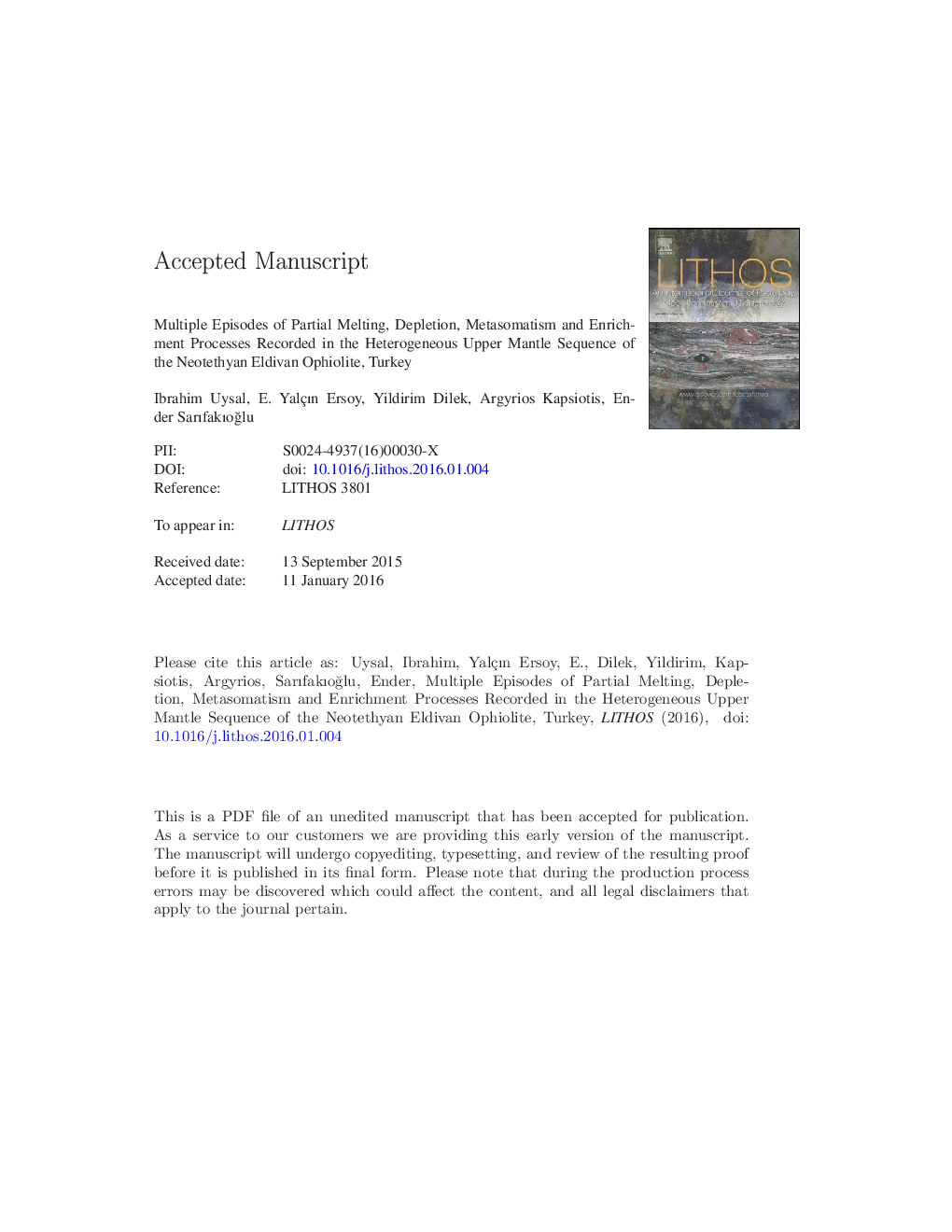| Article ID | Journal | Published Year | Pages | File Type |
|---|---|---|---|---|
| 6440610 | Lithos | 2016 | 57 Pages |
Abstract
The Eldivan ophiolite along the Izmir-Ankara-Erzincan suture zone in north-central Anatolia represents a remnant of the Neotethyan oceanic lithosphere. Its upper mantle peridotites include three lithologically and compositionally distinct units: clinopyroxene (cpx)-harzburgite and lherzolite (Group-1), depleted harzburgite (Group-2), and dunite (Group-3). Relics of primary olivine and pyroxene occur in the less refractory harzburgites, and fresh chromian spinel (Cr-spinel) is ubiquitous in all peridotites. The Eldivan peridotites reflect a petrogenetic history evolving from relatively fertile (lherzolite and cpx-harzburgite) toward more depleted (dunite) compositions through time, as indicated by (i) a progressive decrease in the modal cpx distribution, (ii) a progressive increase in the Cr#s [Cr / (Cr + Al)] of Cr-spinel (0.15-0.78), and (iii) an increased depletion in the whole-rock abundances of some magmaphile major oxides (Al2O3, CaO, SiO2 and TiO2) and incompatible trace elements (Zn, Sc, V and Y). The primitive mantle-normalized REE patterns of the Group-1 and some of the Group-2 peridotites display LREE depletions. Higher YbN and lower SmN/YbN ratios of these rocks are compatible with their formation after relatively low degrees (9-25%) of open-system dynamic melting (OSDM) of a Depleted Mid-ocean ridge Mantle (DMM) source, which was then fluxed with small volumes of oceanic mantle-derived melt [fluxing ratio (β): 0.7-1.2%]. Accessory Cr-spinel compositions (Cr# = 015-0.53) of these rocks are consistent with their origin as residual peridotites beneath a mid-ocean ridge axis. Part of the Group-2 harzburgites exhibit lower YbN and higher SmN/YbN ratios, LREE-enriched REE patterns, and higher Cr-spinel Cr#s ranging between 0.54 and 0.61. Trace element compositions of these peridotites can be modeled by approximately 15% OSDM of a previously 17% depleted DMM, which was then fluxed (β: 0.4%) with subduction-influenced melt. The Group-3 dunite samples contain Cr-spinel with elevated Cr#s (0.73-0.78) and low-TiO2 contents (< 0.13 wt.%), implying higher degrees of melting (21-24%) of an already depleted DMM that was triggered by infiltration of low-Ti boninite melt with fluxing rates of 0.4-4.0%. The existence of interstitial, idiomorphic Cr-spinel (high Cr# and low Ti) in the Group-3 dunites is consistent with this interpretation. The occurrence of both MOR- and SSZ-type peridotites in the Eldivan ophiolite suggests that its heterogeneous upper mantle was produced as a result of different partial melting and melt-rock reaction processes in different tectonic settings within the Neotethyan realm.
Related Topics
Physical Sciences and Engineering
Earth and Planetary Sciences
Geochemistry and Petrology
Authors
Ibrahim Uysal, E. Yalçın Ersoy, Yildirim Dilek, Argyrios Kapsiotis, Ender SarıfakıoÄlu,
